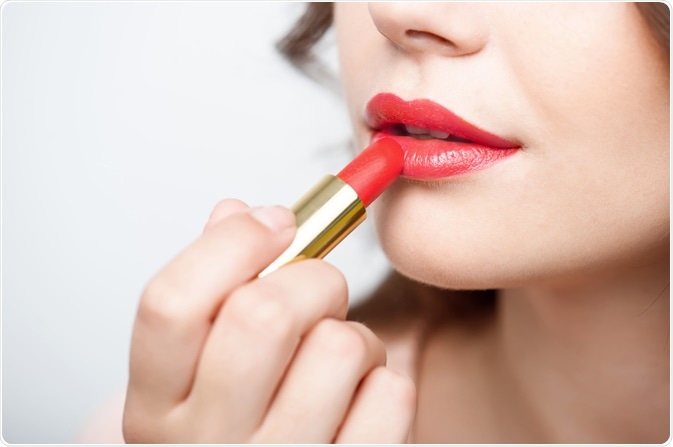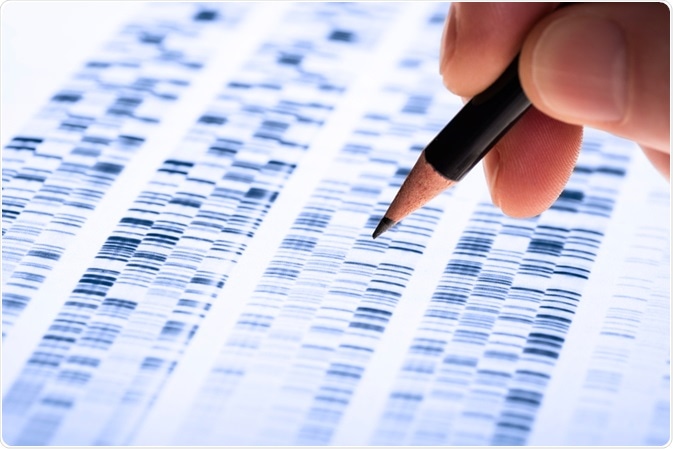Lipstick, on what is usually known as a cosmetic product to enhance the appearance or introduce color to the lips, is now used as a tool in forensic analysis to collect DNA or for comparison analysis between two similar lipsticks from the traces recovered.

Image Credit: Olena Yakobchuk/Shutterstock.com
Lipstick traces can aid forensic investigations through linking a crime scene to a suspect and/or victim as they are often found on clothing, glasses, cigarette butts, and napkins.
Analytical techniques in spectroscopy, such as Raman spectroscopy, ATR-FTIR, GC-MS, ICP-OES, HR-GFAAS, ICP-MS, and AAS have given useful information on lipstick smears to aid forensic investigations.
Chemical composition of a lipstick
Three common ingredients found in lipstick are oil, wax, and dyes/pigments. Color additives from mineral pigments, such as iron oxides and titanium, are responsible for the rich shades of lipstick colors. Lakes and true pigments as organic pigments may also be used as colorants.
Discrimination power from Raman spectroscopy to characterize lipsticks
In a study done by Gardner, et al. describes that Raman spectroscopy is capable of discriminating most of the 80 lipstick samples used, at the 532 nm and 780 nm excitation wavelengths. The results indicate that each shade from the same lipstick product corresponds to their own spectra.
However, Raman spectroscopy is most efficient when dealing with samples under a controlled laboratory environment. This may not be ideal in forensic cases where lipstick smears are often recovered in all kinds of conditions.
Salahioglu, et al indicated that Raman spectroscopy pertains as the most promising analytical technique out of other techniques for its non-destructive nature and very little sample preparation. However, different challenges must be resolved, such as specialized training for users, the scarcity as well as the cost of the instrument. Fluorescence interference could also be an additional problem when the instrument with laser excitation is used when working with a particular sample.
Identifying unknown lipstick traces using FTIR-ATR and chemometric techniques
ATR-FTIR is another technique utilized during criminal investigations to identify an unknown lipstick trace sample. The obtained FTIR spectra show the aromatic and aliphatic compounds that exist within lipstick samples, with an FTIR database of 35 lipsticks and a statistical method.
The role of temperature has also played a part in the analysis, where the switch from a low temperature of 200ºc to a high 500ºc shows peak shifts and different intensities. Gladysz, et al. have analyzed their results through the chemometric techniques, Cluster analysis, and Principal component analysis.
Visual comparison based on the presence of peaks at a wavenumber through IR spectra can also be observed to indicate whether two lipstick samples come from the same origin. However, the visual comparison is time-consuming when the unknown sample has to be compared with hundreds of other samples in a database through observing the peaks in the FTIR spectrum. Furthermore, false positive or false negative results may also be caused by the intensities given by the different proportions of the same chemical composition.
The instrument is beneficial to acquire high specificity for the low amount of sample size. It is also most advantageous when identifying lipsticks in nude colors accurately. It has not only provided differences between lipstick samples based on chemical components, but it has also the relative abundance of these components.
Though ATR-FTIR is a promising technique to identify the unknown samples, yet interpretation of the spectrum may be difficult due to the overlapping peaks of two chemical compounds from the complex lipstick mixture.
Visible spectroscopy characterizing lipsticks based on colors
This spectroscopy technique analyzes the color of different lipstick samples based on the reflectance and absorbance mode measurements. Reflectance spectroscopy is useful for the lipstick traces recovered from cloth or fabric, while absorbance spectroscopy is capable of analyzing the smears from transparent objects.
Visible spectroscopy is most useful for red-colored lipsticks, where the colors appear vibrant. However, the study on visible spectroscopy to analyze lipstick samples has only been done with samples in high quantities. While forensic casework requires analysis to be done with trace level samples deposited on cloth and glass substrates.
Lipstick identification through chromatograms
Lipstick commonly consists of organic compounds that can be identified by the GC-MS instrument by identifying their chemical structures. This discrimination technique relies on the separation behaviors of the organic compounds among stationary and mobile gas phases in the column.
Though lipstick traces are present in small quantities on a crime scene, various studies have shown that comparison between these samples and extracted lipstick samples can be done through GC-MS. Bell, et al. describes the difference in the chromatographic pattern between the pigments in three different lipstick brands despite having closely similar color shade. Each lip cosmetics product is further made unique by each brand through adding or changing additives in the formula.
These variations are made to attract customers through their brand lines, such as having a non-transferable matte finish, or long-lasting lip products.
DNA profiling as another analytical technique from lipstick traces
Laurance, et al. have found that nearly 80% of the lipstick samples analyzed give results regarding the DNA transferred to the lipstick smears. The DNA is extracted using Chelex from BioRad and calculated by the QuantiBlot kit from Applied Biosystems, then purified with a PCR purification kit from Qiagen GmbH. An AmpFISTR® Profiler Plus® PCR Amplification Kit from Applied Biosystems is then used for DNA profiling and the results are analyzed using an ABI 310 Capillary Electrophoresis Genetic Analyser.
The DNA profile can be useful in the case of missing persons, in which the DNA profile recovered from the lipstick sample of a potential missing person can be compared to the DNA profiles of their relative. However, DNA degradation from the lipstick smears recovered may also impose difficulties in DNA profiling. Environmental factors such as UV radiation, temperature, and age can contribute to degradation.

Image Credit: gopixa/Shutterstock.com
Sources:
- Abdullah, A., Marimuthu, Y., Haw, C., Said, N., Muslim, N., Hassan, N., Yaacob, M., Hooi, Y. (2011). Forensic discrimination of lipsticks by thin-layer chromatography and gas chromatography-mass spectroscopy. Malaysian Journal of Forensic Science, 2(1), pp. 22-28. pdfs.semanticscholar.org/07ec/4c1b26bc075cc784da4353b31537253a1206.pdf
- Bell, R., and Hondrogiannis, E., n.d. Differentiation Of Drugstore Lipsticks Using Organic Markers Measured By Gas Chromatography-Mass Spectrometry. www.towson.edu/.../hondrogiannis-poster-2.pdf
- Ezegbogu. M.O, Osadolor, H.B. (2019). Comparative Forensic Analysis of Lipsticks Using Thin Layer Chromatography and Gas Chromatography. World Academy of Science, Engineering and Technology International Journal of Chemical and Molecular Engineering, 13(5), pp. 231-235.
- Gardner, P., Bertino, M. F., Weimer, R. (2010). Differentiation between lip cosmetics using Raman spectroscopy. JASTEE, 6(42), pp. 42-57.
- Gardner, P., Bertino, M., Weimer, R., Hazelrigg, E. (2013). Analysis of lipsticks using Raman spectroscopy. Forensic Science International, 232(1-3), pp. 67-72.
- Sharma, V., Bharti, A., and Kumar, R. (2019). On the spectroscopic investigation of lipstick stains: Forensic trace evidence. Spectrochimica Acta Part A: Molecular and Biomolecular Spectroscopy, 215, pp.48-57.
Last Updated: Aug 30, 2022